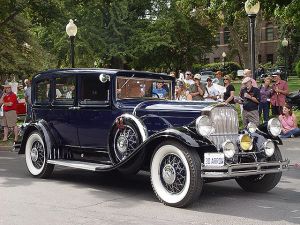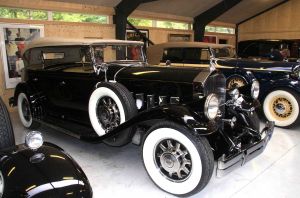- Home
- About Us
- Join/Renew
- Member Benefits
- Member Pages
- Log In
- Help
- Museum Store
I note this car as another example of a number of Pierce-Arrows which have popped up for sale or auction in Europe. Some of them seem to sit on websites for a long time; however, I can see that the asking prices are high, even with the Euro at its current low levels. The point is well taken that buying a vehicle at auction, unless the history is well known, will present some issues, and buying a vehicle overseas just compounds the issues.
I don’t think I’ve ever seen ‘chrome’ artillery wheels.
Was that actually a factory option?
It was an option, I am sure the most expensive of all the wheel options.
Car reported to have a 4 speed transmission, but it is a 3 speed with overdrive. Very few 4 speed cars made after 1930, which was the first and last year to be offered as a standard tranny. Wheels made by Budd were really more of a stainless steel fat spoke than an artillery wheel. Very expensive in those days. Car appears to be very authentic and in good shape. Some one needs to drive it though. Should bring a very good price.
Not overdrive. My ’31 Model 42 had the carry over 4 speed. There was the creeper gear, gearshift lever left detent, and down. Very noisy and hard to downshift while moving. The ’31 owners manual refers to the unit as the optional four speed transmission.
Note the button on the top of the shift knob!
Bill,
That button is to engage the free-wheeling not an overdrive.
Bill
I know the car, and have helped service it. It did not have an overdrive in it when I was helping out with it. As always ANY open Pierce should be INSPECTED by an EXPERT before purchase. Ed.
By the way, the wheels are stainless not chrome. Mandy by Budd and used in 31 and 32. They are quite nice and very rare. I wish I had a set for my 42 D/C.
Yes Bill, I miss spoke. That button was for free wheeling, which was later considered too dangerous and discontinued in all the marks that tried it.
Tony, I had the 4 speed in my 1930 C. That tranny is one of the best and smoothest transmission made. You could change from second to high without touching the clutch, and back again. Wonderful in mixed traffic, and a big sales promotional item. However it was also the most hated tranny ever used because, if it was ever disassembled by an uninformed mechanic it would grind and sometimes rip up the gears. The unit had synchromesh gears on second and high. They were matched with marks on the edge of the teeth and HAD to be lined up exactly. I have some with broken teeth that I would be glad to sell you.
Bill, the 1930 four-speed Clark transmission does NOT have synchronizers. Its primary fault is the spacing of the ratios: 3.12 on the granny First, about 2.2 (off the top of my head) for Second, 1.25 for Third, and 1.00 for Fourth. Huge jump between Second and Third. The Brown-Lipe 4-speed as used in the Broadmoor Hotel cars (and precious few others) was much more of a close-ratio transmission. Pierce’s first syncro box was for 1932.
Sorry George, either you are wrong or we are not using using the same nomenclature. I took mine completely apart and the way it is constructed shows that second and high have permanently meshed gears with curved teeth. the shifting between gears is done by carrier shaft from one set to the other. Their gear teeth never engage or disengage, but are always together. Here is another shot of my car. I believe the term syncromesh is used as a term in the sales brochure. All my stuff is now in storage. That huge jump is accomodated by the constant engagement of the teeth of each gear set. This unit changes gear sets, not geares between second and high. I’ sorry I can’t find a picture of the factory picure of this box and it’s interior. There is an excellent photo in their ad piece. My shifting was very smooth using both the clutch, or without using the clutch, but by only adjusting the engine speed. Because of the design the teeth never have any space between them, but the two power teeth always touch each other.

Bill, for openers let’s separate “gears” from “speeds,” which are being used interchangeably, as we all do. By “speeds,” I’m talking about which ratio is being selected by the driver. Let’s have “gears” be limited to those round thingies with teeth on them.
Your comments have some validity when limited to a discussion of Third and Fourth SPEEDS in the Clark. However, First (granny) and Second are straight-cut gears which require double clutching if the car is not at rest when either of those SPEEDS is selected.
Third and Fourth SPEEDS in the Clark have constant mesh HELICAL herringbone gears, and they are indeed “constant mesh” (see page 28 of the 1930 Prestige catalog and page 31 of “The Story of Pierce-Arrow.”
The same illustration used in both references, and also shows the straight-cut First and Second.
I cannot understand your statement “that huge jump is accommodated by the constant engagement of the teeth of each gear set.” Well, if one is indeed able to move from one SPEED to another, yes, the gearbox “accommodates” that. The “huge jump” from Second to Third (or as Pierce calls it, “intermediate”) works but is not desirable: you must wind the engine up to an unseemly (for a Pierce) rpm before shifting from Second to Third. I must say I do love the 1.25 Third; I just wish the ratios were more closely spaced between 1, 2 and 3.
And one sure as shootin’ must double clutch when shifting from Second to Third/Intermediate–and back.
The illustrations show NO synchronizer assemblies (small bronze teeth, which is what I was referring to, as used in 1932 and later Pierces, in the 4-speed Clark. Wiki defines synchronizers as a subset of constant mesh, so you have a point there.
As I recall, Cadillac pioneered conventional synchromesh about 1928, and the ‘h’ in the spelling may have been a GM Trade Mark. Primarily, Pierce boasted of the helical herringbone gears (about half a degree apart) as SILENT to get away from the ‘singing second” for which big GM cars of the era were famous.
The Clark was an interesting exercise, but Pierce dropped it like a hot rock after the 1930 model year and had an aggressive factory exchange program to put later transmissions (1931 and 1932) in 1930s–as described in reprinted PAMCC bulletins in a PASB circa 2003. (I reviewed that recently but can’t find it as I type this.)
And that’s about all I have time for!
George
Thanks George. If I hit the accelerator just right during the shift I can get it back into second without too much trouble. Going from second to high is just a matter of practice. The very low gear is a granny or parade gear, and I never consider it as “the low/first gear”. I do understand the modern version of a syncromesh, but the term was often used in describing this box. As I’ve said before, this is a love/hate tranny. The company found it better not to continue offering it for good sales reasons. This was designed and built for Pierce’s exclusive use. They out sold the production of it and had to substitute a more standard 3 speed for many of the cars in 1930. For those of you who have one in your car, you need to really understand it well. Don’t exchange it for something else.
A transmission that has syncromesh will have a cone on the sliding gear that the shift fork is fitted to. This cone fits inside a brass ring that has a matching inside cone shape, The outside of the brass ring has a similar cone shape with fine ‘teeth’, almost like fine threads on the surface of the brass cone. This brass cone has a matching recess for it in the gear that the sliding gear will mate with when the gear is engaged.
What happens is the shift lever moves the shift fork, which pushes the sliding gear toward the gear to be engaged, The brass ring acts as a ‘brake’ to bring the sliding gear’s rpm to match the rpm of the gear it is being forced into. The brass ring will not allow the sliding gear to mesh with the other gear until their rpm is the same.
The gear to be engaged can be in constant mesh with the gear on the countershaft, and usually is.
The type of transmission like the Clark in this discussion does not have syncromesh, it does have constant mesh helical cut gears that are silent when in operation, ie: they do not ‘sing’.
It is only by skill and experience that you can shift a Clark transmission without clashing and grinding the gears. A quiet shift can be accomplished with either a quick double clutch, or careful timing of the shift lever to engage the gears when you hope, sense, and timed the shift. The occasional ‘blip’ of the throttle at the precise moment is also a useful technique.
With syncromesh, you just move the lever toward the gear you wish to engage, and gently push the lever, the brass ring will ‘synch’ the rpm of the two gears and the engagement will be silent. If this was done on a non-syncromesh transmission, you would make a lot of noise and some considerable metal grindings inside the transmission.
Good synchromesh will even work to completely change the direction of the sliding gear: such as in many small farm utility tractors that have synchromesh even on reverse gear. The operator of such a tractor can engage reverse gear while traveling forward, without even a hint of a grind from the gears,, and then when the clutch is let our, the tractor skids it’s tires and immediately reverses direction, the operator of the tractor bruising his ribs on the steering wheel.. DON’T ask how I know this !!
Greg Long
I have really had trouble to insert this one but here is a fresh photo the ’31 Pierce I Denmark taken some days ago, which I have received from a friend. On the photo you can see the nice Budd wheels.

Gorgeous car.
I agree!
Here is a Nice video from Denmark. I suppose the most of you also are interested in other classics than only Pierce cars…! I do not know how to have this link inserted in a correct way – you have to copy this line:
http://www.bonhams.com/video/19519/
